Diamond inclusions refer to internal characteristics or flaws within a diamond that emerged during its formation process under extreme heat and pressure deep within the Earth’s mantle. These inclusions or imperfections can include a variety of substances such as minerals, fractures, or even tiny crystals that became trapped inside the diamond while it was forming. Their size, number, position, color, and relief can vary greatly from diamond to diamond.
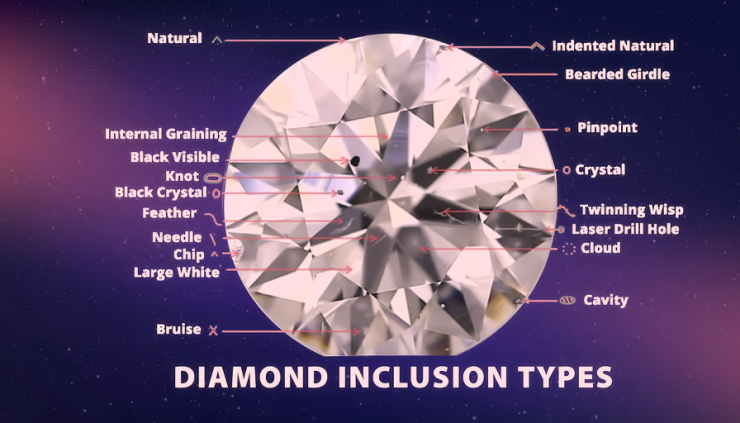
A diamond’s inclusions can significantly impact its clarity grade, which is one of the Four Cs (Cut, Carat, Color, Clarity) used to evaluate a diamond’s quality and value. Clarity refers to the absence of inclusions and blemishes, so a diamond with fewer or no inclusions will have a higher clarity grade. The Gemological Institute of America (GIA) has established a clarity scale ranging from Flawless (no inclusions or blemishes visible under 10x magnification) to Included (inclusions and/or blemishes visible to the naked eye).
Inclusions can have varying effects on a diamond’s appearance. Some inclusions might be visible to the naked eye, appearing as small spots, clouds, or lines within the stone, while others are so small or positioned in such a way that they can only be observed under magnification. For instance, if an inclusion is near the pavilion of a diamond—the bottom part of the stone—it might be less noticeable than one located near the table or the top facet.
While inclusions are often viewed as flaws or imperfections, it’s important to note that they can also provide unique “fingerprints” for individual diamonds, aiding in their identification. In some cases, certain types of inclusions can even add to a diamond’s beauty and unique character. They are natural evidence of a diamond’s journey from deep within the Earth to the surface, and to many, this narrative holds a certain allure.
However, inclusions can also potentially affect a diamond’s durability. Significant inclusions, especially if they are near or break the surface, can make a diamond more prone to chipping or cracking.
Inclusion visibility, type, and location are all critical factors that a jeweler or gemologist considers when determining a diamond’s clarity grade, value, and overall appeal. Therefore, understanding diamond inclusions is essential for anyone in the market for a diamond, whether for investment purposes or jewelry.
Types of Diamond Inclusions
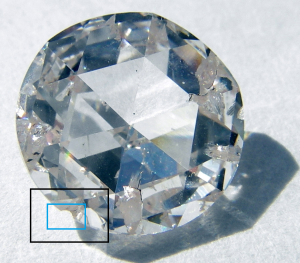
A bearded girdle refers to a condition where there are numerous minute fractures extending into the diamond from the girdle edge. This can result from the cutting process and can give the girdle a fuzzy or “bearded” appearance. Depending on the severity, it may affect the stability of the diamond.
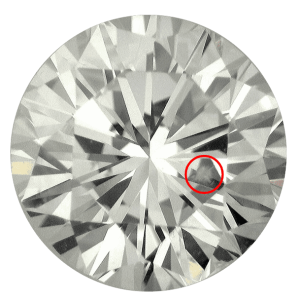
A bruise is an inclusion consisting of surface crumbling, often accompanied by tiny, root-like feathers. It’s usually the result of a hard knock. This might not be immediately visible and may require magnification to spot, but it can potentially weaken the structural integrity of the diamond.
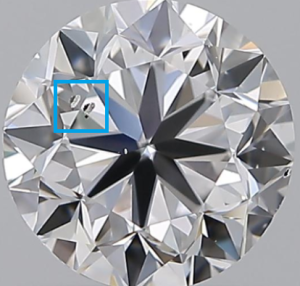
A cavity is a type of inclusion that’s a void or large opening in the diamond. It might occur naturally during the diamond’s formation or it could be a result of the cutting process. Depending on the size and location, it might gather dirt and oils, which can affect the brilliance and clarity of the diamond.
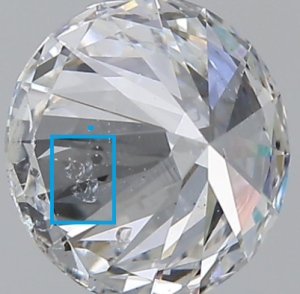
A cloud is a group of minute inclusions, crystals, or structural deformations within the diamond that are too small to distinguish individually but together, they appear like a hazy cloud under magnification. They can reduce the transparency of the diamond, affecting its clarity grade.
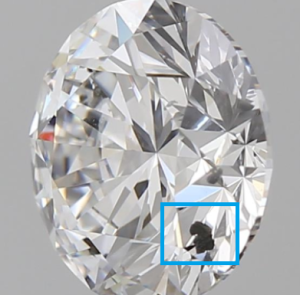
A crystal is a mineral deposit trapped within the diamond. The nature and color of these crystals can vary widely. Some are transparent and hardly affect the diamond’s appearance, while others can be dark and visible to the naked eye. Crystals give each diamond a unique fingerprint.
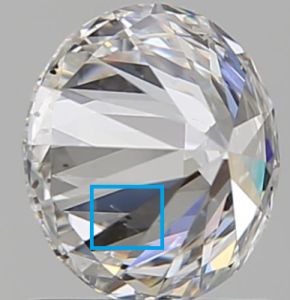
A feather is a type of inclusion that looks like a white or transparent feather within the diamond. They are basically tiny fractures inside the diamond and can sometimes extend to the surface. If a feather is located near the edge of a diamond or is large, it might affect the diamond’s durability.
A grain center is a small, concentrated area of crystal distortion. These areas may display a different color from the rest of the diamond under polarized light. Grain centers are internal features and do not pose a threat to the diamond’s durability.
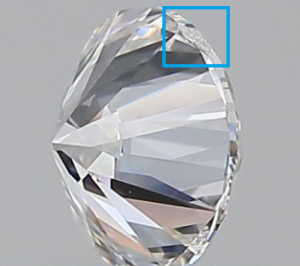
An intended natural is a portion of the original rough diamond’s surface, or skin, that’s left on the polished diamond, often on or near the girdle. This is usually done intentionally to maximize the diamond’s carat weight, and it shows up as a small, flattened area with a different texture.
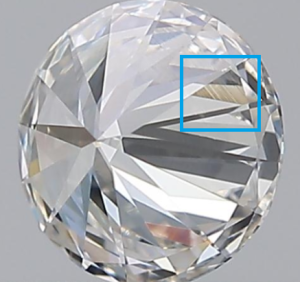
Internal graining is internal irregular crystal growth that may appear as lines, curves, or angles in the diamond when viewed under magnification. This feature might appear milky or like faint lines or streaks, and can sometimes interfere with the passage of light, reducing the diamond’s clarity.
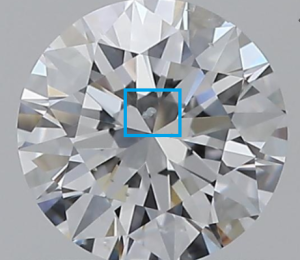
A knot is an included diamond crystal that extends to the surface after the cutting and polishing process. From the surface, it may resemble a raised area on a polished facet; under magnification, a knot may appear to have a rounded or angular outline.
A laser drill hole is a tiny, thin, tube-like passage made by a laser. It’s a man-made feature, created to reach and bleach a dark inclusion, improving the diamond’s apparent clarity. While laser drilling can enhance a diamond’s appearance, it’s considered a clarity enhancement treatment and should be disclosed at the point of sale.
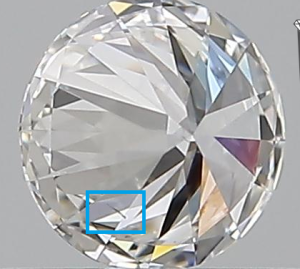
A needle is a long, thin, crystal inclusion that looks like a tiny rod or needle. They are often white, but can also be dark. They may be solitary, or they could appear in clusters. If needles are small and few, they have little effect on a diamond’s appearance.
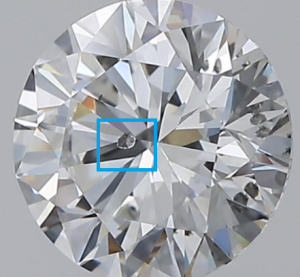
A pinpoint is a tiny crystal, often white, black, or transparent, that’s embedded in the diamond. Pinpoints are the most common type of inclusion in diamonds. They are usually not visible to the naked eye and have minimal impact on the diamond’s clarity grade, unless they appear in clusters.
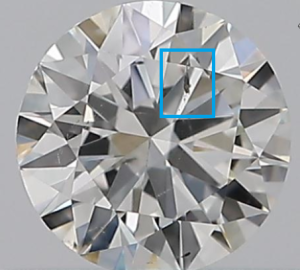
A twinning wisp is a series of pinpoints, clouds, or crystals that forms in a diamond’s growth place. They are typically long and ribbon-like, and they’re usually the result of a diamond’s crystal structure twisting or distorting during its formation. They can affect the clarity of the diamond, depending on the size and location.
Inclusions can occur during the formation process of the diamond or can be introduced after the diamond has been formed. They can be caused by a variety of factors, including stress, heat, and the presence of other minerals. The presence of inclusions can lower the clarity grade of a diamond and may affect its overall value. However, some inclusions are so small or difficult to see that they do not significantly impact the diamond’s appearance or value.
It is important to note that every diamond will have some level of inclusions, even if they are not visible to the naked eye.
Some Inclusions Decrease Value More Than Others
There are several types of inclusions that can significantly decrease the value of a diamond. In general, inclusions that are large, numerous, or easily visible to the naked eye are more likely to negatively impact the value of the diamond. Here are some examples of inclusions that can be particularly value decreasing:
- Black inclusions: Black inclusions, such as carbon spots, can be particularly noticeable and can significantly decrease the value of the diamond.
- Large feathers: Large feathers, which are small, white or transparent inclusions that resemble feathers, can be particularly noticeable and can decrease the value of the diamond.
- Cavities: Cavities, which are small, hollow openings in the diamond, can be noticeable and can decrease the value of the diamond.
- Large clouds: Large clouds, which are groups of small, cloudy inclusions, can be noticeable and can decrease the value of the diamond.
- Large crystals: Large crystals, which are small, transparent minerals that are embedded in the diamond, can be noticeable and can decrease the value of the diamond.
And Some Inclusions Decrease Value Less Than Others
Here are some examples of inclusions that tend to decrease the value of a diamond the least:
- Pinpoints: Pinpoints are small, round inclusions that are located on the surface of the diamond. They are typically small and not easily visible to the naked eye, and therefore have a lesser impact on the value of the diamond.
- Crystals: Crystals are small, transparent minerals that are embedded in the diamond. As long as they are small and not easily visible, they tend to have a lesser impact on the value of the diamond.
- Needles: Needles are small, slender inclusions that look like needles. As long as they are few in number and not easily visible, they tend to have a lesser impact on the value of the diamond.
- Internal graining: Internal graining is a series of lines or grooves within the diamond. As long as it is not easily visible, it tends to have a lesser impact on the value of the diamond.
- Twining twisps: Twining twisps are small, twisted inclusions that look like twigs. As long as they are few in number and not easily visible, they tend to have a lesser impact on the value of the diamond.
It is important to note that the impact of inclusions on the value of a diamond can vary depending on the specific characteristics of the diamond, such as its size, shape, and overall quality. In general, diamonds with fewer and smaller inclusions are more valuable than those with larger or more numerous inclusions.